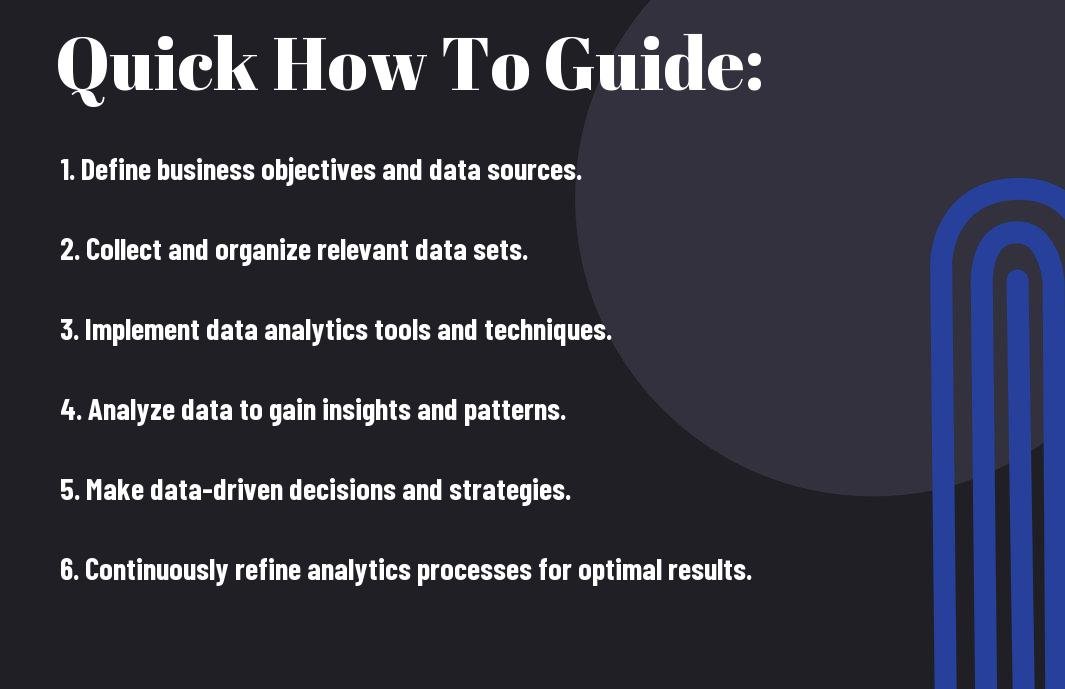Many businesses today are sitting on a goldmine of valuable information without even realizing it. Big data presents an incredible opportunity for companies to gain insights, make informed decisions, and ultimately drive business success. However, the sheer volume and complexity of data can be overwhelming without the right tools and strategies in place. In this comprehensive guide, we will research into the world of data analytics and explore how businesses can harness the power of big data to gain a competitive edge in today’s marketplace.
From improving operational efficiency to enhancing customer experiences, the applications of data analytics are vast and varied. By leveraging advanced analytical techniques and technologies, businesses can uncover hidden patterns, trends, and insights that can transform their operations and drive growth. However, with great power comes great responsibility. It is crucial for businesses to prioritize data security and privacy to mitigate the risks associated with big data analytics. This guide will not only cover the benefits of data analytics but also address the potential challenges and provide actionable tips for overcoming them.
Whether you are new to the world of big data analytics or looking to refine your existing strategies, this guide is your go-to resource for unlocking the full potential of data analytics for business success. By the end of this article, you will have a deeper understanding of how data analytics can revolutionize your business operations and help you stay ahead in today’s data-driven world.
Key Takeaways:
- Data Analytics Drives Business Success: Utilizing data analytics helps businesses make strategic decisions based on patterns and insights.
- Big Data Enables Better Understanding: Analyzing large volumes of data allows businesses to gain a deeper understanding of customer behavior and market trends.
- Enhanced Customer Experience: Big Data helps in personalizing customer experiences by tailoring products and services to specific needs.
- Improved Operational Efficiency: By analyzing data, organizations can streamline processes, reduce costs, and enhance productivity.
- Competitive Advantage: Companies that effectively harness Big Data gain a significant edge over competitors by making data-driven decisions.
- Risks Mitigation: Data analytics can help identify potential risks and threats early, allowing proactive measures to be taken to mitigate them.
- Innovation and Business Growth: Big Data fosters innovation by providing valuable insights that can drive new product development and business growth strategies.

Foundation of Big Data Analytics
You may have heard about the power of big data and how it can revolutionize businesses, but where do you start? The foundation of big data analytics lies in establishing a data-driven culture within your organization. This means making data a central part of your decision-making process and encouraging all employees to use data to drive their actions.
How-To Establish a Data-Driven Culture Within Your Organization
While it may seem daunting at first, establishing a data-driven culture is crucial for unlocking the full potential of big data. Start by ensuring that your leadership team is fully on board with the idea of using data to make decisions. This top-down approach will set the tone for the rest of the organization and show employees that data is a priority. Provide training and resources to help employees become more data literate and comfortable using analytics tools. Encourage a mindset shift towards data-driven decision making, where hypotheses are tested and validated with data before taking action.
Factors to Consider When Building Your Big Data Infrastructure
Pertaining to building your big data infrastructure, there are several factors to consider to ensure success. Think about the volume, variety, and velocity of data that your organization will be dealing with.
- Scalability: Ensure that your infrastructure is scalable to handle growing amounts of data.
- Data Security: Implement measures to protect sensitive data and comply with regulations.
- Data Quality: Invest in processes to ensure that your data is accurate and reliable.
- Integration: Ensure that your data infrastructure can integrate with other systems and tools seamlessly.
This will set the foundation for a robust big data infrastructure that can support your organization’s analytics needs.
Consider how adopting big data analytics can revolutionize the way your organization operates by providing valuable insights and driving strategic decision-making. By investing in the right infrastructure and fostering a data-driven culture, your organization can unlock the full power of big data and stay ahead of the competition. This transformative shift towards a data-centric approach can lead to improved efficiency, innovation, and ultimately, greater business success. Make sure to take these factors into account when building your big data infrastructure to set your organization up for success in the data-driven era.

Data Collection Strategies
How-To Identify and Capture Valuable Data for Your Business
After deciding to implement data analytics in your business strategy, the next crucial step is to identify and capture valuable data. Collection of relevant data is the foundation on which successful data analytics is built. Start by clearly defining your business goals and objectives. This will help you determine what data points are important for achieving those goals. Data sources can vary from customer interactions, sales transactions, website analytics, social media engagement, to even industry reports and surveys.
Once you’ve identified the type of data you need, the next step is to develop a data collection plan. This plan should outline how data will be gathered, stored, and analyzed. Implement tools and technologies that can assist in automating the data collection process, ensuring efficiency and accuracy. Regularly review and update your data collection plan to adapt to changing business needs and technology advancements. Keep in mind, the quality of data collected will directly impact the effectiveness of your data analytics efforts.
Regularly evaluate the data being collected to ensure it aligns with your business objectives. Cleanse and organize the data to maintain its accuracy and relevance. Establish data governance policies to maintain data integrity and security. Investing in training for your team on how to effectively capture and manage data is crucial for the success of your data analytics initiatives. By following these steps, you can effectively identify and capture valuable data to drive informed business decisions.
Tips for Ensuring Data Quality and Integrity
Capture data quality and integrity are paramount for successful data analytics. It is important to establish processes and protocols to ensure the accuracy and reliability of the data being collected. Regularly monitor and audit your data collection methods to identify any errors or inconsistencies. Implement data validation checks to verify the quality of incoming data and prevent inaccuracies from affecting your analysis.
- Conduct regular data quality assessments to identify and address any issues
- Standardize data formats and naming conventions to maintain consistency
- Implement data security measures to protect sensitive information
It is important to remember that the quality of your data will determine the effectiveness of your data analytics. By prioritizing data quality and integrity in your data collection strategies, you can ensure that your business decisions are based on reliable and accurate information. The success of your data analytics initiatives relies on the trustworthiness of the data foundation.

Data Processing Techniques
All businesses today are inundated with vast amounts of data, ranging from customer information to sales figures. To make sense of this data and turn it into actionable insights, data processing techniques play a crucial role. One of the key challenges that businesses face is processing large volumes of data efficiently to extract valuable insights in a timely manner.
How-To Process Large Volumes of Data Efficiently
Processing large volumes of data efficiently requires the use of advanced technologies and techniques such as parallel processing, distributed computing, and data partitioning. Parallel processing involves breaking down tasks into smaller sub-tasks that can be processed simultaneously, speeding up the overall process. Distributed computing allows for data processing to be distributed across multiple nodes or machines, further enhancing speed and efficiency.
Data partitioning involves dividing the data into smaller partitions that can be processed independently, reducing the processing time. By leveraging these techniques, businesses can effectively process large volumes of data in a scalable and efficient manner, enabling them to derive valuable insights and make informed decisions swiftly.
This approach not only enhances the speed of data processing but also ensures accuracy and reliability in the insights generated, helping businesses stay ahead in today’s competitive landscape.
Factors Affecting Data Processing Speed and Accuracy
Little factors can significantly impact data processing speed and accuracy, such as hardware capabilities, software optimization, and data quality. Hardware capabilities refer to the processing power and memory of the systems used for data processing, which can influence the speed at which data is processed.
- Software optimization involves efficient coding practices and algorithms that can enhance the speed and accuracy of data processing.
- Data quality plays a crucial role in the accuracy of insights generated, as inaccurate or incomplete data can lead to erroneous conclusions.
This emphasizes the importance of investing in robust infrastructure, optimizing software, and maintaining high-quality data for efficient data processing.
Factors Affecting Data Processing Speed and Accuracy
Another critical factor that can impact data processing speed and accuracy is network latency. Network latency refers to the delay in data transmission between nodes or machines, which can slow down the processing speed and affect the accuracy of results. By minimizing network latency through efficient network configurations and technologies, businesses can ensure faster and more accurate data processing.
Data Storage Solutions
Despite the vast amount of data businesses generate and collect, many struggle with finding the right data storage solutions to effectively manage and analyze this information. With the evolution of technology, there are various options available to meet the diverse needs of businesses. From traditional on-premise servers to cloud-based solutions, each has its advantages and considerations when it comes to scalability, cost, and security.
How-To Choose the Right Data Storage Solutions for Your Business Needs
Some key considerations when choosing data storage solutions include the amount of data your business generates, the necessary access speeds, and the level of security required. For smaller businesses with limited data storage needs, cloud-based solutions such as Amazon Web Services (AWS) or Google Cloud Platform can provide cost-effective and scalable options. Larger enterprises may opt for on-premise solutions or a hybrid approach to maintain control over their data while leveraging cloud services for additional storage and processing power.
When assessing data storage solutions, it is important to consider factors such as data backup and recovery capabilities, compliance with industry regulations, and data encryption practices. By evaluating these aspects, businesses can ensure that their data is protected from potential breaches or loss, mitigating the risks associated with storing sensitive information. Any data storage solution chosen should align with the business’s needs and growth trajectory to avoid disruptions or data migration challenges in the future.
Tips for Data Management and Security
Assuming data management and security are top priorities, implementing best practices can help businesses safeguard their valuable information and optimize data usage. Regular data audits and classification can help identify sensitive data that requires additional protection, while implementing access controls and user permissions can restrict unauthorized access. Encryption of data both at rest and in transit is crucial for maintaining data integrity and confidentiality.
For instance, businesses should prioritize implementing multi-factor authentication and intrusion detection systems to monitor and prevent unauthorized access to their data storage solutions. Regular security updates and patches should be applied to mitigate vulnerabilities and reduce the risk of cyber-attacks. Any suspicious activity should be promptly investigated and addressed to prevent potential data breaches. By staying proactive and vigilant in managing data security, businesses can uphold their reputation and build trust with customers and partners.
Data Analysis and Interpretation
How-To Perform Effective Data Analysis to Extract Business Insights
Many businesses today are sitting on a goldmine of data, but extracting valuable insights from this data can be a daunting task. With the right approach, data analysis can provide businesses with valuable information to make informed decisions and drive success. To perform effective data analysis, start by clearly defining the objectives of the analysis. Understanding what information you are looking to extract from the data will guide the entire process.
Once the objectives are set, gather the relevant data from various sources and ensure its quality and accuracy. Next, employ data analytics tools and techniques to process the data and uncover patterns, trends, and correlations. Visualization tools can then be used to present the findings in a clear and actionable format. Finally, interpret the results in the context of your business goals to derive meaningful insights that can drive strategic decisions.
Effective data analysis requires a combination of technical skills, domain knowledge, and critical thinking. By following a structured approach and leveraging the power of data analytics tools, businesses can unlock the full potential of their data and gain a competitive edge in the market.
Factors That Influence Data Interpretation in Different Business Contexts
With businesses operating in diverse industries and environments, factors influencing data interpretation can vary significantly. Some of the key factors to consider include the complexity of the data set, the business objectives driving the analysis, and the industry trends impacting the interpretation of data.
Other factors such as the availability of skilled analysts, the technological infrastructure supporting data interpretation, and the regulatory environment in which the business operates can also play a crucial role in shaping how data is interpreted. Understanding and navigating these factors is necessary to ensure that the insights derived from data analysis are accurate, relevant, and actionable.
- Complexity of the data set
- Business objectives
- Industry trends
This nuanced understanding of the factors influencing data interpretation is key to harnessing the power of data analytics for business success. By addressing these factors effectively, businesses can enhance the reliability and relevance of their data-driven insights, ultimately leading to better decision-making and improved outcomes.
Data Visualization and Communication
How-To Use Data Visualization Tools to Communicate Insights Clearly
For businesses looking to harness the power of data analytics, data visualization tools are vital in effectively communicating insights to stakeholders. To ensure that insights are understood clearly, it is important to choose the right visualization tools that align with the type of data being presented. Whether it’s through charts, graphs, dashboards, or interactive visualizations, the goal is to make complex data more digestible and engaging for the audience.
Clearly labeling data points, using colors purposefully, and simplifying visual elements can help in enhancing the clarity of the insights being communicated. With the right data visualization tools, businesses can transform raw data into actionable insights that drive informed decision-making.
By leveraging data visualization tools effectively, businesses can not only communicate insights clearly but also uncover hidden patterns and trends within their data. This can lead to more strategic decision-making and a better understanding of the business landscape.
Tips for Crafting Data-Driven Stories That Drive Decision Making
There’s a significant difference between presenting data and telling a compelling story with data. To craft data-driven stories that drive decision-making, it is important to identify the key insights and trends that will resonate with your audience. By weaving these insights into a cohesive narrative, businesses can create a more impactful story that influences decision-making.
Using real-life examples, anecdotes, and scenarios can help in making data more relatable and understandable for stakeholders. Additionally, focusing on the impact of the insights presented and tying them back to the overall business objectives can reinforce the importance of data-driven decision-making.
This approach not only enhances the effectiveness of data communication but also empowers stakeholders to make more informed decisions based on data-driven insights. By crafting compelling stories that resonate with the audience, businesses can drive meaningful change and enhance their competitive advantage in the marketplace.
Implementing Data-Driven Strategies
How-To Integrate Data Analytics into Business Strategy Development
Unlike traditional methods, harnessing the power of data analytics for business success requires a strategic shift towards incorporating data-driven strategies into every aspect of operations. Some key steps to integrate data analytics into business strategy development include identifying relevant data sources, defining clear business objectives that align with data insights, and establishing the necessary infrastructure and tools for effective analysis.
By leveraging data analytics in business strategy development, organizations can gain valuable insights to make informed decisions, optimize processes, and drive innovation. It is crucial to involve cross-functional teams in this integration process to ensure alignment between data initiatives and business goals. Additionally, continuous monitoring and evaluation of data analytics outcomes are important to adapt strategies in real-time and stay ahead of the competition.
Implementing data analytics in business strategy development is a continuous journey that requires a cultural shift towards data-driven decision-making. Investing in employee training and fostering a data-driven mindset across all levels of the organization are key to maximizing the benefits of data analytics. By embedding data-driven practices into the organizational culture, companies can unlock new opportunities, improve performance, and achieve sustainable growth.
Factors to Consider for Successful Implementation and Change Management
Implementing data-driven strategies involves several critical factors that businesses must consider for successful integration and change management. Some of these factors include leadership buy-in, adequate resource allocation, clear communication of data insights, and proactive change management strategies to address resistance and ensure smooth adoption.
- Leadership buy-in: Securing support from top management is crucial to driving a data-driven culture throughout the organization.
- Resource allocation: Allocating sufficient resources, including budget, technology, and skilled manpower, is important for successful implementation of data-driven strategies.
- Clear communication: Effectively communicating data insights and the value of analytics to stakeholders helps in fostering collaboration and engagement.
Perceiving data-driven strategies as a strategic imperative rather than a mere trend is vital for businesses aiming to stay competitive and thrive in the digital age. Embracing a data-driven culture and proactively addressing change management challenges will position organizations for long-term success in an increasingly data-centric business environment.
Maintaining and Scaling Big Data Systems
How-To Ensure Your Big Data Systems Remain Effective Over Time
Not properly maintaining and scaling big data systems can lead to inefficiencies and decreased performance over time. It is crucial for businesses to continuously monitor and optimize their data infrastructure to ensure it meets the evolving needs of their operations.
Assuming your company’s data needs will grow and change, regular maintenance and upgrades are important. This includes monitoring system performance, identifying bottlenecks, and implementing solutions such as adding more storage, upgrading processing power, or optimizing algorithms.
Regular data quality checks and ensuring data security measures are up to date are also critical to maintain the integrity of the system. By implementing best practices for data governance and security, businesses can prevent data breaches and ensure compliance with regulations.
Tips for Scaling Your Data Solutions in Line With Business Growth
Little preparation goes a long way when it comes to scaling your data solutions in line with business growth. It is important to have a scalable architecture in place from the beginning to accommodate future growth and prevent system failures.
- Invest in scalable infrastructure: Ensure your hardware and software can handle increases in data volume and processing demands.
- Utilize cloud services: Cloud computing platforms offer scalability and flexibility to expand your data solutions as needed.
- Implement data partitioning: Divide your data into smaller, more manageable chunks to improve performance and scalability.
Recognizing the signs of strain on your data systems, such as slow performance or frequent crashes, is key to proactively addressing scalability issues. By continuously monitoring and optimizing your data infrastructure, you can ensure it remains effective and efficient as your business grows.
Staying Ahead: Trends and Innovations in Big Data and Analytics
How-To Keep Up With Emerging Trends in Data Analytics
To keep up with the ever-evolving landscape of data analytics, businesses need to continuously monitor emerging trends and innovations in the field. One way to stay ahead is by investing in ongoing training and development for your data analytics team. By providing your team with the latest tools and knowledge, you can ensure that they are equipped to handle new challenges and opportunities in the world of big data.
Networking with other industry professionals and attending conferences and workshops can also help you stay informed about emerging trends in data analytics. By connecting with experts and thought leaders in the field, you can gain valuable insights and stay ahead of the curve. Additionally, following industry publications and blogs can help you stay up-to-date on the latest advancements in data analytics.
Lastly, it’s crucial to foster a culture of innovation and experimentation within your organization. Encouraging your team to think outside the box and explore new approaches to data analytics can lead to groundbreaking discoveries and a competitive edge in the market. By embracing change and staying agile, your business can adapt to emerging trends and drive success.
Factors Shaping the Future of Big Data in Business
An increasing focus on real-time data analytics is shaping the future of big data in business. With the ability to analyze data as it is generated, organizations can make quicker and more informed decisions, leading to greater efficiency and competitiveness. Additionally, the rise of artificial intelligence and machine learning is revolutionizing the way businesses leverage big data, enabling them to uncover valuable insights and automate processes.
- Cloud computing is playing a crucial role in the future of big data, providing businesses with scalable and cost-effective solutions for data storage and analysis.
- Data security and privacy concerns are becoming increasingly important as businesses collect and analyze large volumes of sensitive information. Implementing robust security measures and ensuring compliance with regulations is important for building trust with customers.
- Data ethics is also a key consideration in the future of big data, as businesses grapple with ethical dilemmas related to data collection, usage, and sharing.
After considering these factors, businesses that can adapt to the changing landscape of big data and leverage the latest technologies and insights will be well-positioned for success in the future.
FAQ
Q: What is Big Data?
A: Big Data refers to large and complex sets of data that traditional data processing applications are inadequate to deal with. It involves processing and analyzing massive volumes of data to extract valuable insights.
Q: Why is Big Data important for businesses?
A: Big Data is crucial for businesses as it helps in making informed decisions, understanding customer behavior, improving operational efficiency, and gaining a competitive edge in the market.
Q: What is Data Analytics?
A: Data Analytics is the process of examining data sets to draw conclusions about the information they contain. It involves applying statistical analysis and machine learning techniques to identify patterns and trends in data.
Q: How can businesses harness the power of Data Analytics?
A: Businesses can harness the power of Data Analytics by collecting relevant data, cleaning and organizing it, analyzing the data using appropriate tools and techniques, and using the insights gained to make strategic decisions.
Q: What are the benefits of using Big Data and Data Analytics for business success?
A: The benefits of using Big Data and Data Analytics for business success include improved decision-making, enhanced operational efficiency, better understanding of customer needs, personalized marketing strategies, and increased profitability.
Q: What are some common challenges in implementing Big Data and Data Analytics in businesses?
A: Some common challenges in implementing Big Data and Data Analytics in businesses include data security and privacy concerns, lack of skilled professionals, integration of data from multiple sources, and ensuring data quality and accuracy.
Q: How can businesses overcome the challenges of implementing Big Data and Data Analytics?
A: Businesses can overcome the challenges of implementing Big Data and Data Analytics by investing in data security measures, providing training to employees, using data integration tools, and establishing data governance policies to ensure data quality and compliance.







